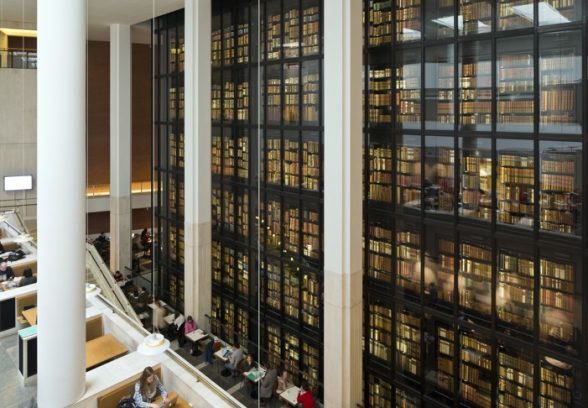This website uses cookies
This website uses cookies to enable it to function properly and to analyse how the website is used. Please click 'Close' to accept and continue using the website.




The Twentieth Century Society is delighted that the British Library has been listed at grade I. We were consulted by Historic England as part of the assessment and we strongly supported the designation of this London landmark at the highest grade. It was listed along with seven other libraries across the country all designated at grade II as part of a national survey of twentieth century library buildings by Historic England.
The grade II listings include Suffolk Record Office, Suffolk (1963-65) by Donald McMorran; Bebington Central Library, The Wirral (1967-71) by Paterson, Macauley and Owens; Milton Keynes Central Library, Milton Keynes (1979-81) by Buckinghamshire County Council architects; and Lillington Library, Leamington Spa, Warwickshire (1959-60) by Henry Fedeski.
The British Library was designed in 1975-8, built 1982-99, and opened in 1997. The architect was Sir Colin St John Wilson, with M.J. Long, Douglas Lanham, John Collier, John Honer and many more. The complex includes 11 reading rooms, the magnificent King’s Library tower and an outstanding collection of art including Eduardo Paolozzi’s giant statue Newton (1995) after William Blake. It was the largest public building to be built in Britain in the twentieth century.
The building is clad inside and out in hand made red bricks from Leicestershire – chosen because they were made of the same clay as those used for the adjoining St Pancras Station and Hotel. Inside, American White Oak is used for the joinery throughout, and the wall finishes are Travertine, Portland Witbed and Purbeck limestone.
Henrietta Billings, Senior Conservation Adviser, Twentieth Century Society said: “The British Library, together with its specially commissioned public art is a magnificent building of international standing. The Grade I listing is a well-deserved celebration of its design, quality and contribution to twentieth century British architecture.”
Grade I buildings are of exceptional interest – out of approximately 500,000 listed buildings in England, only 2.5% are Grade I. In their listing advice, which was agreed and signed off by Heritage Minister Tracey Crouch, Historic England recommended listing for the following reasons:
* Architectural interest: for its stately yet accessible modernist design rooted in the English Free tradition with Arts and Crafts and classical influences, crisply and eloquently contextualised by its massing and use of materials which respect and contrast to the St Pancras station and hotel;
* Materials: for its level of craftsmanship and skilful handling of a range of materials externally and internally, including Travertine, Portland and Purbeck stone, granite, Leicestershire brick, bronze and American white oak throughout, carefully and meticulously detailed;
* Interior: for the well-planned interior spaces comprising the generously lit reading rooms and multi-level atrium, successfully fulfilling the brief to create the nation’s Library;
* Historic Interest: in the tradition of the Royal Festival Hall, it is a landmark public building incorporating at its heart the King’s Library, given to the nation by George III;
* Architect: a major work by the eminent architect and academic Sir Colin St John Wilson and his architectural partner, M.J. Long. Wilson has a number of listed buildings to his name notably the St Cross libraries at the University of Oxford (Grade II*);
* Artistic interest: for the fusion of art with architecture as a component of the design ethos, exemplified by Paolozzi’s Newton in the piazza;
* Group Value: with the Grade I St Pancras Hotel, Grade II Camden Town Hall and Grade II housing on Ossulston Street.
Commenting on the listings of the seven local libraries, Henrietta Billings said: “We are delighted that the architectural and historical significance of these public library buildings has been recognised. They showcase a fantastic range of architectural styles and materials, and we hope that the listings will increase awareness of twentieth century library architecture – a building type that is increasingly under threat.”
The full list of twentieth century library listings:
Historic England News story
Nominated for 1998 in 100 Buildings

Become a C20 member today and help save our modern design heritage.